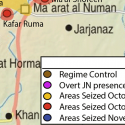 |
 |
Jabhat al-Nusra Deepens its Foothold in Northwestern Syria
Nov 10, 2014 - Jennifer Cafarella


Jabhat al-Nusra (JN) seized large swaths of the Jabal al-Zawiya area of southern Idlib Province (in northwest Syria bordering Turkey) from Free Syrian Army (FSA)-affiliated groups beginning in late October 2014 (see fig. 1). JN, the official al-Qaeda affiliate in Syria, began to carve out direct territorial control in Idlib Province beginning in July 2014, and its advance in southern Idlib has considerably extended its stronghold in the province. JN’s campaign in Idlib has largely targeted terrain held by the FSA-affiliated Syrian Revolutionaries Front (SRF), and is therefore an important indicator of JN’s strength in relation to Syria’s moderate opposition and its willingness to escalate against Western-backed groups in pursuit of its own core interests. JN’s ability to sideline moderate elements in Idlib challenges the viability of the U.S. “train and assist” mission for these elements. However, JN was careful to caveat its escalation by stating that it continued to support SRF affiliates that “remain focused on the fight against the regime.” JN’s actions in Idlib therefore do not yet rise to the level of a direct challenge to the moderate opposition in its entirety, and rather remain limited to a narrow JN campaign for consolidation in the wake of the ISIS advance. Nonetheless, JN remains likely to escalate against the full spectrum of rebel groups receiving Western aid once it assesses a certain threat level has been reached in terms of the likelihood that these groups will turn on JN in favor of securing meaningful Western support.
JN and allied rebel forces seized control of a primary stronghold for Syria’s moderate opposition in the Jabal al-Zawiya area of southern Idlib province beginning in late October 2014. In so doing, JN effectively neutralized the FSA-affiliated Syrian Revolutionaries Front (SRF) in Idlib Province in addition to targeting Harakat Hazm, a second FSA-affiliate. A leader of the January 2014 uprising against the Islamic State of Iraq and al-Sham (ISIS) in northwestern Syria, the SRF has been considered a potential ally in the U.S. “train and assist” mission to the Syrian opposition and is representative of the reliance of the U.S. strategy in Syria on the existence and reliability of key moderate groups through whom Western influence can be channeled. Prior to the conflict with JN, SRF leader Jamal Ma’arouf had reiterated his commitment to defeating ISIS and appeared to be a natural conduit for increased Western assistance. In addition, both the SRF and Harakat Hazm appear to be recipients of a covert U.S. program supplying certain vetted groups with TOW anti-tank missiles, considered to be a flagship effort for the train and assist mission to the Syrian opposition.